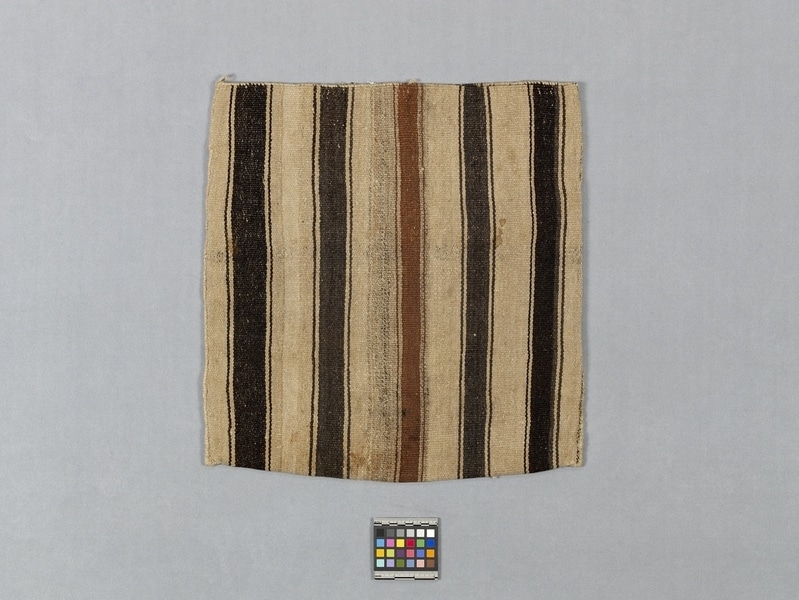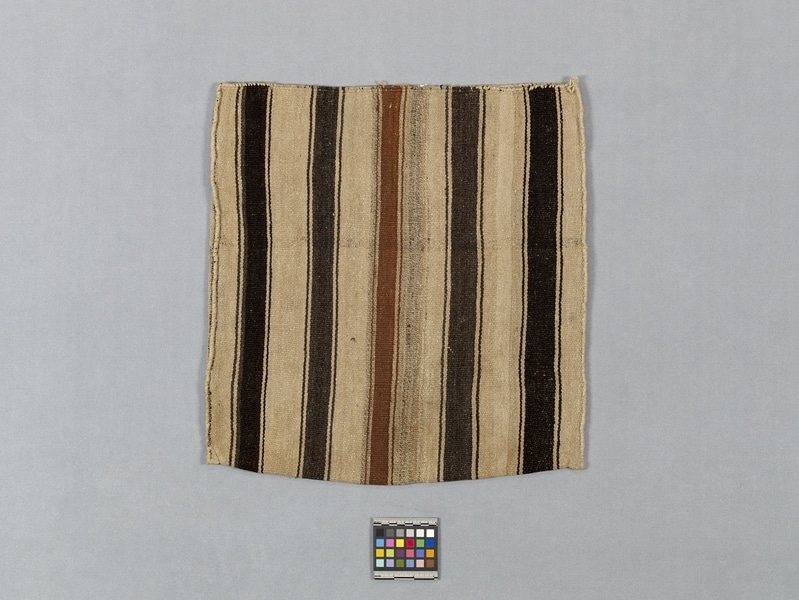Bag Item Number: Sf390 from the MOA: University of British Columbia


Description
Bag of variegated light shades of natural beige wool with five vertical bands of coloured wool and alpaca wool. Each band is bordered by a narrow stripe. The stripe groupings are arranged symmetrically with brown in the middle, then grey, then black at the outside. The side seams are solidly overcast making a bulky, round edging. The bag mouth is reinforced in parts with overstitching.
History Of Use
Warp-faced fabric with three or four selvedges are woven by women but the fabrics are used by both sexes. The techniques, structures and some of the motifs have pre-Conquest antecedents. This type of textile conveys the most information about an individual's ethnicity, sex, age, status and particular history. Formerly, sacks were woven to sizes that served to measure goods for trading. This size is 1 arroba which carries between 12-13 kilos of potatoes. This bag filled with potatoes was exchanged with the high altitude herders for the same bag filled with alpaca. With the shift from barter to cash, the sacks are no longer used as measures. A cash price per kilo is established for each good. Trade between people living at different altitudes in the Andes is an ancient and continuing practice. Factory woven plastic sacks commonly serve as containers today.
Cultural Context
trade;domestic storage
Iconographic Meaning
Josepha and her family had no knowledge of meanings attached to the coloured stripes.
Specific Techniques
Sheep's wool, z spun and plied 2 s with one stripe grouping of brown alpaca; warp faced plain weave; 4 selvedge fabric is folded and sewn on the sides with overcasting. Bag mouth partially reinforced with overcasting. For trade, bag is filled and mouth is sewn shut.
Narrative
Bought from the maker, Josefa Huatta Yucra, who made the bag about forty years ago. Up to 25 years ago, she used this bag for trading potatoes for alpaca fibre with the herders. In recent times, the bag has been used for storing balls of yarn in the house. Josefa had sewn a red woven strap on the sack to make it into a shoulder bag which she deemed would be more saleable to an outsider. I had her remove the new strap when I purchased it.
Item History
- Made by Josepha Huatta Yucra (Maker) in Taquile, Puno, Peru between 1940 and 1950
- Collected by Mary Frame during 1987
- Owned by Josepha Huatta Yucra
- Owned by Mary Frame before November 3, 1987
- Received from Mary Frame (Seller) and Museum of Anthropology Shop Volunteers (Funding source) on November 3, 1987
What
- Name
- Bag
- Identification Number
- Sf390
- Type of Item
- bag
- Material
- wool fibre and alpaca wool fibre
- Manufacturing Technique
- spun, plied, woven and sewn
- Overall
- height 51.0 cm, width 48.0 cm
Who
- Culture
- Quechua
- Creator
- Josepha Huatta Yucra (Maker)
- Field Collector
- Mary Frame
- Previous Owner
- Josepha Huatta Yucra and Mary Frame
- Received from
- Mary Frame (Seller) and Museum of Anthropology Shop Volunteers (Funding source)
Where
- Holding Institution
- MOA: University of British Columbia
- Made in
- Taquile, Puno, Peru
When
- Creation Date
- between 1940 and 1950
- Collection Date
- during 1987
- Ownership Date
- before November 3, 1987
- Acquisition Date
- on November 3, 1987
Other
- Item Classes
- textiles
- Condition
- good
- Accession Number
- 1274/0003